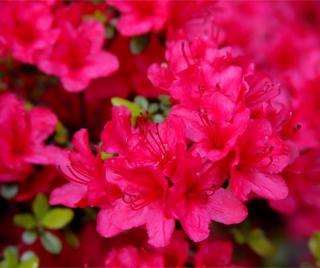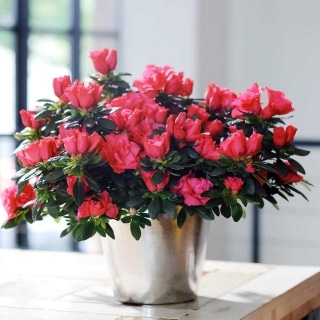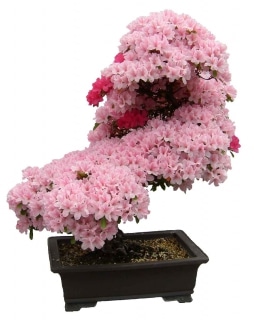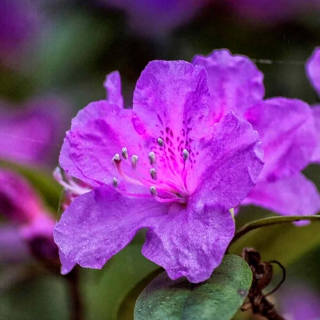

Azalea japonica is a small heath shrub that provides evergreen, bushy growth.
Key Azalea japonica facts
Name: Azalea japonica
Scientific: Rhododenron azaleastrum Tsutsusi
Family: Ericaceae
Type: shrub
Height: 3 ½ to 6 ½ feet (100 to 200 cm)
Exposure: part sun/shade plant
Soil: acidic, heath soil – Foliage: evergreen – Flowering: mid → end-spring
Its main appeal, however, is the massive blooming: beautiful flowers ranging from pink to red, purple and white. Since it grows up to 5 to 6 ½ feet (1.5 to 2 meters) tall, depending on the species, Azalea japonica is the ideal shrub to fill in a heath plant flower bed. But it’s also excellent as an indoor shrub!

To generate spectacular blooming, add heath plant fertilizer upon planting and then regularly during the growth phase.
It isn’t necessary to prune the plant. Nonetheless, if you wish to balance the shape or reduce the size of your azalea, wait until blooming is over.
The surface-most roots of Azalea japonica are the most thirsty roots. They especially require frequent watering in spring and summer.

Depth of the container or pot isn’t an issue, to the point that you can save soil by filling the lower half with rocks or hollow space fillers.
It’s best to wait for the blooming to end before repotting. Flowers are very demanding in terms of nutrients, which is why you shouldn’t risk damaging the fragile root system at this time.
This is especially true if the pot is rootbound. Indeed, rootbound plants have roots that circle round and round in their pot. Usually this happens when repotting is delayed.
After the blooming, prune the branches lightly and shape the plant as described above, and proceed to repot immediately.

Repot your Azalea japonica bonsai very carefully every two years. Root systems tear apart easily so again, proceed with caution.
Your Japanese azalea might have to fend off red spider mites, leaf gall, and root rot.
If leaves start swelling, curling over and growing fleshy bulges, you’re facing a case of leaf gall.
This is a fungal disease induced by the Exobasidium vaccinii germ.
Here are a few symptoms of this damaging disease:
By the time you notice this on your shrub, sadly, it’s usually too late to heal the plant. You’re facing a case of root rot caused by Phytophthora bacteria.
We’ve talked about the ‘Satsuki’ and the ‘Kurume’, two hybrids only propagated through cuttings. But there are many more types of Azalea japonica to be explored!
 Satsuki – often called ‘late-blooming’ because it only blooms at the end of spring (May to June).
Satsuki – often called ‘late-blooming’ because it only blooms at the end of spring (May to June).Thanks to the many varieties, it’s only a question of time until you find an Azalea japonica that hits your sweet spot!
Three key reasons explain why Azalea japonica are often grouped within the Azaleastrum section of the Rhododendron family:
So, in a way, they’re simply a group within the larger Rhododendron family.
Japanese azalea is said to be an evergreen azalea. This means it keeps its leaves in winter. The plant only sheds older leaves when newer ones have taken over, except for the rare bout of really cold weather. On the other hand, regular azaleas are often deciduous and will lose all their leaves every year in the cold season, even during mild winters.
Additionally, azaleas of the deciduous type have larger, longer leaves. This contrasts with Japanese azaleas that have smaller leaves, at most 2 inches (5 to 6 cm) long.
This shrub is actually a small-flowered rhododendron. It bursts forth in spring with a beautiful bright and colorful bloom.
Moreover, Azalea japonica grows into a nice round shrub. This dense shape is perfect because it highlights the generous blooming and the deep green leaves.
Note that Azalea japonica might lose its leaves in case of strong frost spells, but this won’t have any incidence on the plant itself.
When grown indoors, Azalea japonica helps purify indoor air from ammonia. It’s that unpleasant smell from house-cleaning products and pet urine.
To enhance shrub growth, mulch the ground around it to retain moisture.
Favor any acidic mulch such as pine bark mulch.
Hello! Thank you for all the useful information. I got an azalea japonica and it was doing very well untill I went on vacation and left it on a badly calibrated automatic watering system. I think it didn’t provide it with enough water because the beautiful green leaves that it had before were all dried up. I have been trying to revive it but it no new leaves are growing. The stem is no longer the same brown colour and is now a bit whiter. Is there any way I can help it improve?
Usually underwatering isn’t as bad as overwatering. I’m supposing you found the soil in the pot very dry.
Hopefully, with proper watering, it’ll revive on its own. What you can do is snip the tip of a branch off. If it snaps off and is very brittle, that branch might be dead already due to lack of water. Another way to check if the plant is still alive is to scrape a little bark off: if the underside is glistening, seems wet, and is green-hued, then it’s still alive. If it’s dry up to the white wood, then it might also be dead.
So if you see some life still in various places, then all you need is patience and regular watering. Important is to water but without letting the plant wallow in water. Let the pot drain in the sink before putting it back in its saucer.
Merabalar bahçeme bende çalı japon acelyasi almak istiyorum ama istanbulda nereden tedarik edebilirim bilgisi olan arkadaşlar bana yazarsa sevinirim
“I want to buy bush Japanese Azalea in my garden of Merabalar, but I would be glad if friends with the knowledge of where to supply in Istanbul write to me”
Hello Kamil, Nature & Garden doesn’t sell plants directly. If you search for “Azalea Japonica Istanbul” on a search engine, several suppliers appear: Plantistanbul, Fidanistanbul… Try getting in touch with them.
Merhaba Kamil, Nature & Garden, bitkileri doğrudan satmaz. Bir arama motorunda “Azalea Japonica İstanbul” ararsanız, birkaç tedarikçi görünür: Plantistanbul, Fidanistanbul … Onlarla iletişime geçmeyi deneyin.
Hello Gaspard, thank you for your reply and for adding the information on repotting. I had already repotted it before I read your reply. I did use the correct compost. I will send you some pics to your email address and you will see how absolutely beautiful it is. It gets the early morning sun, shade all day and sun again from 4.30pm to about 7.30pm and it seems to be coming along nicely, as they don’t like full sun all day. One thing to ask can I feed it with Miricle-Gro All Purpose Soluble Plant Food, as I did read somewhere on the website (not your website) that it does’nt need fertiliser. Can you help with this.
Hi,I’ve bought a Azalea Japonica ‘Agadir’ but I’m not green fingered,.
Read the instructions,semi-shaded area,etc,etc, on the pot it says 75cm,and can take up to 20 yrs to mature,.
So when is it best to prune back the shrub and how far back to prune?
And remove ‘dead heads’ too? A
I have been given an azalea Japonica lollipop tree. It is in full flower but I think it is potbound.
Some websites tell me not to repot when it is in flower and other sites are showing repotting when in flower. Also have you got to have the azalea compost of can I use ordinary peat. Can you please help.
Hi Margaret, you’re lucky to have gotten such a nice gift! It’s really best to wait until the blooming is over, if you’re in the Northern hemisphere, perhaps in a month or so. Add compost if you can, peat is good but lacks nutrients.
Also is it O.K to feed my tree with Doff Multi Purpose Feed.
Hi Margaret, yes, it’s perfectly possible to use that brand. It’s a balanced fertilizer, meaning there’s equal proportions of nitrogen, potassium, and phosphorus. It’s important not to use too much, though. Carefully follow the label. Also, remember that it’s only necessary to fertilize during Spring. Once the blooming is over, adding too much fertilizer would actually be detrimental to root growth.